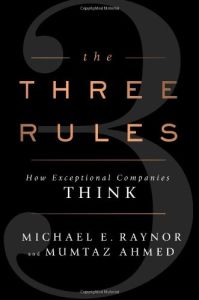Join getAbstract to access the summary!

Join getAbstract to access the summary!
Michael E. Raynor and Mumtaz Ahmed
The Three Rules
How Exceptional Companies Think
Portfolio, 2013
What's inside?
For superior, long-lived results, put performance before price and revenue before costs.
Recommendation
How do some companies turn in exceptional performance year after year? Deloitte’s Michael E. Raynor and Mumtaz Ahmed apply a disciplined, statistically rigorous approach to determine what makes top companies great. The fruit of their impressive research is three pivotal rules any company can follow. To uncover this strategic knowledge, the authors worked as diligent “corporate paleontologists,” carefully analyzing the “fossil record” of high-performing companies to discover what makes them special. The authors back up their research with 110 pages of detailed appendices that reflect the meritorious rigor of their approach. Their intense research methods are solid and praiseworthy, but their opaque writing style is wearying, as is their criticism of other books that offer business advice based on anecdotes and one-off observations. getAbstract recommends their thorough analysis and practical findings to CEOs, COOs, business owners, organizational strategists, business professors, entrepreneurs, investors and avid students of the application of managerial theory to practical problems.
Summary
About the Authors
Michael E. Raynor, a director at Deloitte Services LP, is the author of The Strategy Paradox and The Innovator’s Manifesto. Mumtaz Ahmed is chief strategy officer at Deloitte Consulting LLP.



















Comment on this summary